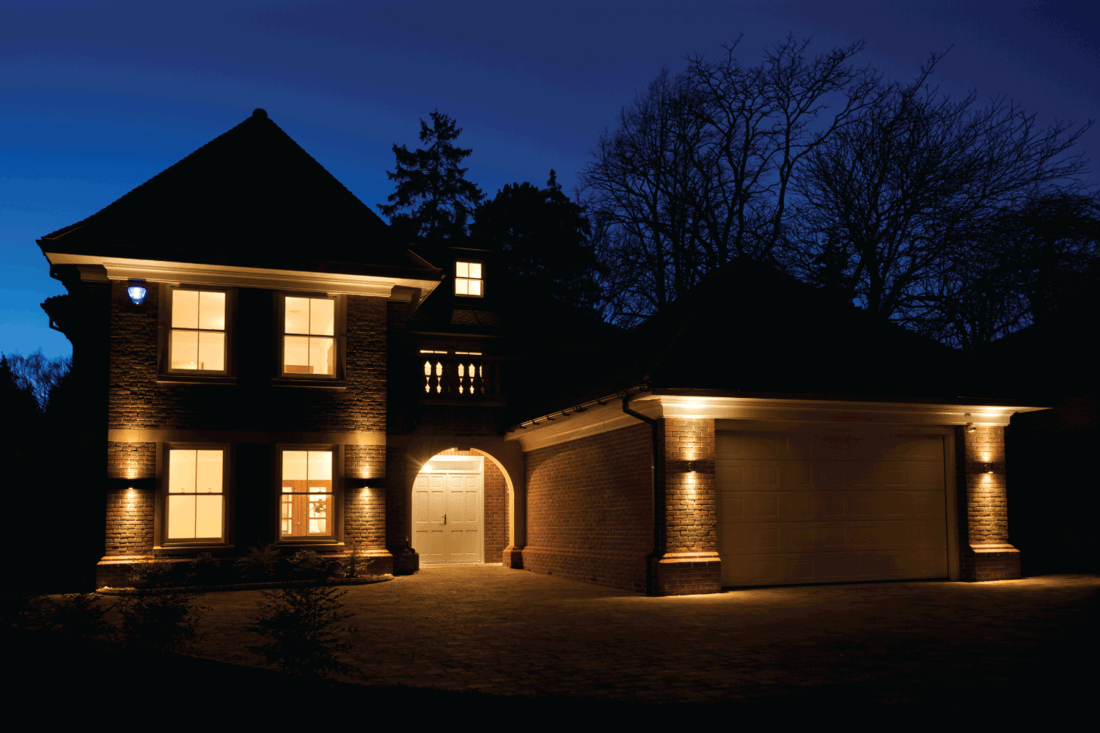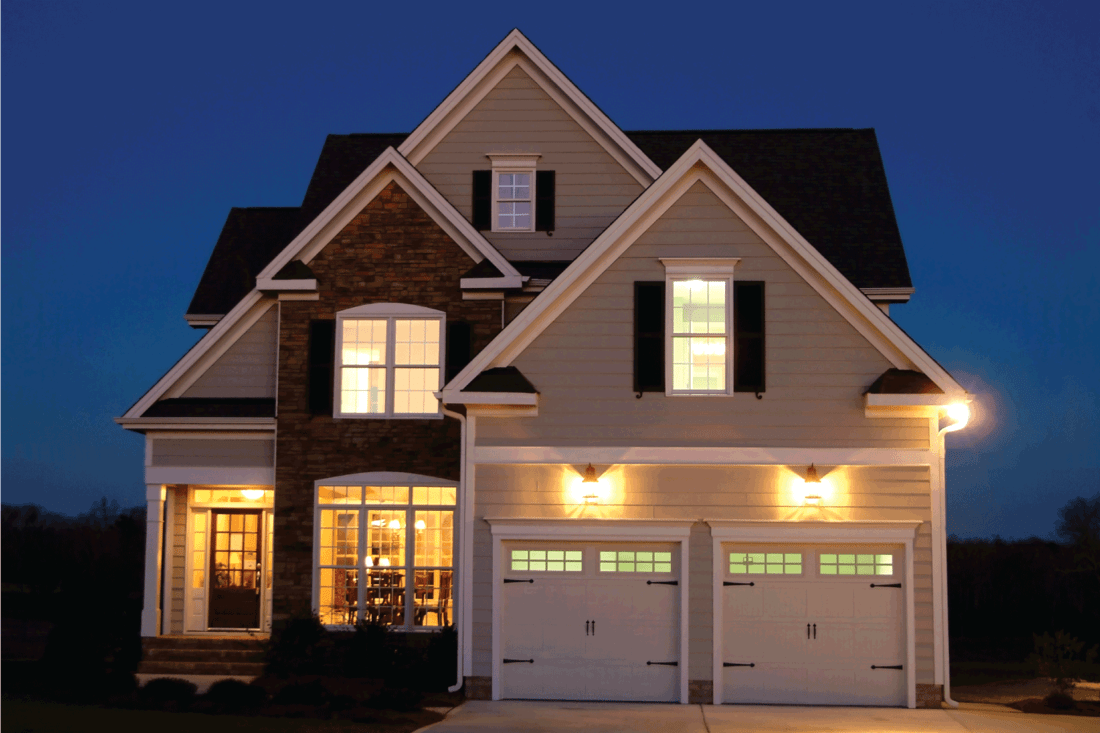Exterior garage lights are a way to help your home stand out at night and make sure you're able to reach the front door safely. What appears to be the smallest change on your house actually has a huge impact! Even though light fixtures look massive in the store, they can end up being too small once you install them. We've looked into how big, and bright exterior lights near a garage should be for maximum efficiency.
A guideline to follow for light size is to measure one-third to one-fourth of the garage door's height. Use a tape measure to measure from top to bottom of the garage door to determine the overall size. The brightness of these fixtures can range from 220 lumens for a smaller area to 1300 lumens for floodlights.
Take your time deciding on outdoor lighting. Accidentally picking a light too small or too big tends to be one of the most common homeowners' mistakes when renovating. By adorning your home with exterior lights near the garage, you will add a huge safety element to your home, as well as illuminate nearby paths and help others find your home in the dark. Keep reading to learn about installation tips and how to style fixtures to fit your home.

How to determine lighting size to garage door size?
Lighting fixtures that are too small can get lost in the surrounding walls. But, fixtures that are too big could end up looking very out of place and take attention away from other key points of your home. If you're a visual kind of person, here is a helpful tip: cut multiple cardboard sizes or the like out, then use them as placeholders for where the lights will go. Once they're up, go stand across the street and see how each size looks from a distance.
Single car garage
A majority of single garage doors will only need one light. This light should be placed on the side of the garage closest to a pathway. Single light fixture styles may vary by your personal taste and the aesthetic of your facade. There are options for hanging lights known as pendant lights, commonly used when there is an overhang and placed in the center. Or keep them flush if there is no overhang with regular exterior lights.
We may include affiliate links and curated AI content to highlight top design styles.
Click here to view this pendant light on Amazon.
Two cars or larger garage
Any garage that is bigger than a single should be adorned with two or more lights. Standard-sized double car garages can have lights placed on the left and right side walls for even illumination. Slightly larger double car garages or multiple single car garages have a tendency to look crowded with too many lights. If this is your situation, try evenly spacing hanging lights for large doors and placing hanging lights in the center of single doors.

How high should exterior garage lights be?
The rule of thumb for light height is to be above eye level. The center of the light should be anywhere between 66 inches to 72 inches; anything higher than 72 inches may get drowned out in the distance. Lights situated at eye level could end up stunning you once you step out of your car. If your eyes are already adjusting to the dark and then a low light greets you around the corner, you'll be left standing outside in a daze.
How many watts should an outside light be?
Growing up, a majority of home lights were incandescent and measured in wattage. Comparatively, with the surge of LED bulbs on the market, the brightness put out is now rated in lumens. For example, a 60 watt light bulb is typically used around the home for brighter areas, which is 700 lumens. How many watts you need depends on how many other lights are nearby and how far you need the light to reach.
If you're using one exterior light by your garage, 400 lumens will be bright enough alongside the front porch light. It will help to keep in mind your other light sources. In this case, will you have pathway lights or inside light coming through the windows? For two exterior lights, you can use two 220 lumen bulbs on each side. Garages that are long and may use pendant lighting can use higher lumens, such as 400, for each to cover the wider area.
It is important to check your local light pollution policies. Houses closer to bodies of water may need lower light emissions for animal safety. You'll also have the benefit of being able to see more of the night sky! Here is another useful tip for light courtesy: turn on your lights and walk outside at night. Where are your lights pointed, and are they going into any neighbor's windows?
Click here to view these outdoor light bulbs on Amazon.
Do all exterior lights need to match?
While you might think you'll need to buy all matching light fixtures, it is actually better to mix it up a little. Lights that will be in pairs will need to match for uniformity, but they don't need to exactly match other outdoor light fixtures. Take a good look at your home and make a note of what color metal accents you have already. You can pick light fixtures of the same color finish and then have different styles throughout.
In other words, your bronze door handle could be the starting point and then base the fixture style off your home. A more modern and geometric house will fair well with clean-lined light. In comparison, a Mediterranean home with a grander feel would pair best with detailed metalwork. If you aren't sure what style your home is but happen to have a trim, you can always match the two.

Are motion sensor lights worth it?
Motion sensor lights pick up heat waves from a passing figure and electronically turn them on. The fact that they only turn on when activated has two main advantages: security and savings. Instead of being on all the time or needing to be turned on when you get home, these lights are self-sufficient. In the worst-case scenario, if a stranger was walking too close to your home, these lights would turn on and startle the intruder.
To expand on the note that they aren't constantly on, you'll also be lowering your electricity bill. Sensor lights come on when there is activity. No need to leave them on before you go to work because when you pull up to the garage, they'll automatically turn on. Of course, you can always keep the front porch light on or have solar-powered path lights if need be.
Solar vs. Timers
Solar-powered lights have a small panel on the top that charges in the sunlight. As the sun goes down, the lights start to turn on through an internal switch. Their installation and upkeep are also much easier. These lights only require rechargeable batteries to store their energy and don't need to be wired to anything, just drill them into your desired spot.
Another upgrade to exterior lights is a timer feature. With current modern technology, you can either have a physical timer to set or connect them to your phone. Timers are able to turn on and then off whenever you choose. More advanced home systems can even let you set different lights at different time intervals.
Click here to view these solar-powered sensor lights on Amazon.
To summarize
As you look at exterior garage lights knowing the correct size will make it a much smoother process. Garage lights should be one-third or one-fourth the size of the garage door and placed above eye level. Experimenting with a cutout place holder will give you the full visual. In terms of brightness, light bulbs are calculated in lumens more commonly than watts. Smaller areas will only need 400 lumens or 40 watts. While larger garages will need multiple 220 lumens and 700 lumens for floodlights.
Now that your home is lit and visible, it's time to revamp the rest of the exterior! Check out these articles for inspiration:
100 Fabulous Front Porch Ideas




![Epoxyshield vs. Rocksolid: Which is Better? [Pros, Cons & Differences Explained]](https://homedecorbliss.com/wp-content/uploads/2023/08/shutterstock_1764682379-600x400.jpg)
